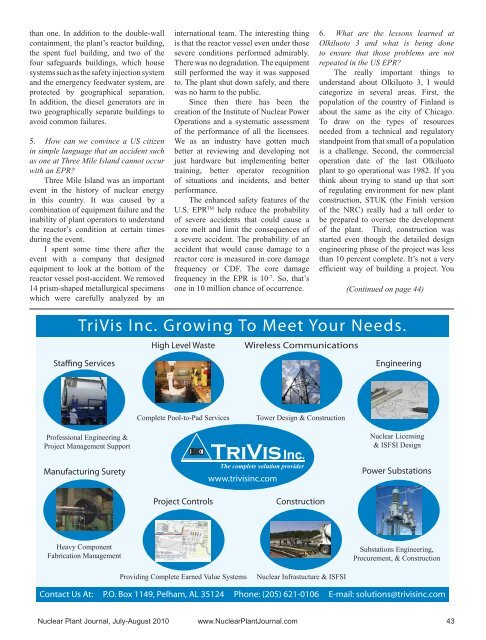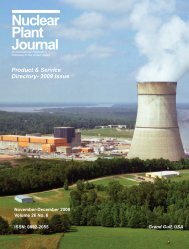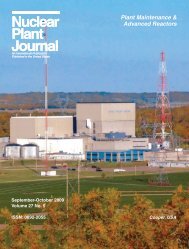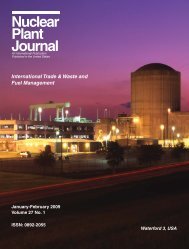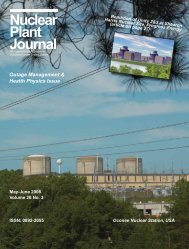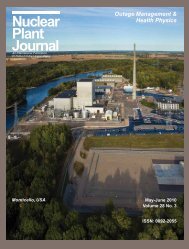Savings with Fleet StandardizationBy Michael McGough, UniStar <strong>Nuclear</strong>Energy.1. How is UniStar structured as anorganization?UniStar <strong>Nuclear</strong> Energy is a 50-50joint venture by Constellation Energy andEDF whose charter is to develop a fleetof advanced new nuclear energy facilities.Some people understandably confuseUniStar with Constellation Energy<strong>Nuclear</strong> Group (CENG), which ownsfive reactors in Maryland and New York.CENG is a separate joint venture fromUniStar. CENG is a newly formed entity,established in late 2009, and owned50.1% by Constellation Energy and49.9% by EDF.2. How much are we dependent on theUS government loan guarantee program,and what are the prospects for receivingthe loan guarantee program for CalvertCliffs 3?U.S. federal loan guarantees are anessential part of the nuclear revival in thiscountry. They enable companies such asUniStar to secure financing from lendersby providing a debt guarantee covering theregulatory and financial risks associatedwith developing the nation’s first newnuclear energy facilities in more than 30years.The Energy Policy Act of 2005established $18.5 billion for federal loanguarantees for new nuclear plants. InFebruary of this year the U.S. Departmentof Energy awarded Southern Company$8.2 billion of that amount whichleft $10.2 billion remaining for otherprojects.In addition to Southern Company, theU.S. Department of Energy selected threeother projects to enter the final phase ofdue diligence for federal loan guaranteesAn interview by Newal Agnihotri, Editor,<strong>Nuclear</strong> <strong>Plant</strong> <strong>Journal</strong> at the <strong>Nuclear</strong>Energy Institute’s <strong>Nuclear</strong> EnergyAssembly in San Francisco, California inMay, 2010.Michael McGoughMichael S. McGough is a Senior VicePresident, for UniStar <strong>Nuclear</strong> Energywhere he is responsible for the growth– UniStar’s Calvert Cliffs 3, NRG’s SouthTexas Project, and South Carolina Electricand Gas Company’s V.C. Summer Project.Those three projects are in various stagesof working with the DOE on their loanguarantee.We’ve completed our application forCalvert Cliffs 3 so that the Departmentof Energy has the information it needsto determine whether we will be arecipient of a loan guarantee. Our projectis ready to go, and we’re hopeful thatthe Department of Energy will makea decision to grant us a loan guarantee.There is an approval process that theDepartment of Energy must first gothrough with the Office of Managementand Budget, the White House, and theSecretary of the Department of Energy toapprove the issuance.3. How can we explain to the generalpublic the nuclear energy technicalitiessuch as probabilistic risk assessment anddefense in depth to make them understandthat our plants are safe?With all of our acronyms andtechnical-speak, we as an industry havea long way to go in improving how weexplain what we do to the general public.and development of new nuclear U.S.EPR power plants in the United States.Mr. McGough has 31 years of nuclearenergy industry experience and haspublished and presented more than 30technical papers on topics ranging fromsteam generator replacement projectsto recovery efforts from the accident atThree Mile Island.He has a BS in engineering (physicalmetallurgy) from Washington StateUniversity and an MBA from the KatzSchool of Business at the Universityof Pittsburgh. He also is a graduateof Northwestern University’s KelloggManagement Institute.At UniStar, we have observed a numberof public opinion polls and focus groupsto try and understand what the generalpublic thinks about nuclear power andto help us explain things in a simplerfashion. For example, to explain acontainment building, if you say that it isa four and a half foot thick concrete wallwith reinforced steel bars bigger thanmy forearm, it helps to create a visualimage. Then if you say that a containmentbuilding is what houses every operatingnuclear plant in the United States, andthat they didn’t have one of those atChernobyl, people understand that.4. Olkiluoto 3, I believe has doublecontainment and several other features toprevent a terrorist attack. What has beenimprovised in the US EPR to make it safefrom a terrorist attack?We selected the EPR because webelieve it’s an extremely safe plant. TheEPR is the only nuclear power plantdesign that has a double-wall containment-- two 4.3 foot thick concrete walls. Whenyou look at airplane crash protection,and you look at the safety of the plantin the unlikely event of a terrorist attack,two containment structures are better42 www.<strong>Nuclear</strong><strong>Plant</strong><strong>Journal</strong>.com <strong>Nuclear</strong> <strong>Plant</strong> <strong>Journal</strong>, July-August 2010
than one. In addition to the double-wallcontainment, the plant’s reactor building,the spent fuel building, and two of thefour safeguards buildings, which housesystems such as the safety injection systemand the emergency feedwater system, areprotected by geographical separation.In addition, the diesel generators are intwo geographically separate buildings toavoid common failures.5. How can we convince a US citizenin simple language that an accident suchas one at Three Mile Island cannot occurwith an EPR?Three Mile Island was an importantevent in the history of nuclear energyin this country. It was caused by acombination of equipment failure and theinability of plant operators to understandthe reactor’s condition at certain timesduring the event.I spent some time there after theevent with a company that designedequipment to look at the bottom of thereactor vessel post-accident. We removed14 prism-shaped metallurgical specimenswhich were carefully analyzed by aninternational team. The interesting thingis that the reactor vessel even under thosesevere conditions performed admirably.There was no degradation. The equipmentstill performed the way it was supposedto. The plant shut down safely, and therewas no harm to the public.Since then there has been thecreation of the Institute of <strong>Nuclear</strong> PowerOperations and a systematic assessmentof the performance of all the licensees.We as an industry have gotten muchbetter at reviewing and developing notjust hardware but implementing bettertraining, better operator recognitionof situations and incidents, and betterperformance.The enhanced safety features of theU.S. EPR TM help reduce the probabilityof severe accidents that could cause acore melt and limit the consequences ofa severe accident. The probability of anaccident that would cause damage to areactor core is measured in core damagefrequency or CDF. The core damagefrequency in the EPR is 10 -7 . So, that’sone in 10 million chance of occurrence.6. What are the lessons learned atOlkiluoto 3 and what is being doneto ensure that those problems are notrepeated in the US EPR?The really important things tounderstand about Olkiluoto 3, I wouldcategorize in several areas. First, thepopulation of the country of Finland isabout the same as the city of Chicago.To draw on the types of resourcesneeded from a technical and regulatorystandpoint from that small of a populationis a challenge. Second, the commercialoperation date of the last Olkiluotoplant to go operational was 1982. If youthink about trying to stand up that sortof regulating environment for new plantconstruction, STUK (the Finish versionof the NRC) really had a tall order tobe prepared to oversee the developmentof the plant. Third, construction wasstarted even though the detailed designengineering phase of the project was lessthan 10 percent complete. It’s not a veryefficient way of building a project. You(Continued on page 44)TriVis Inc.The complete solution provider<strong>Nuclear</strong> <strong>Plant</strong> <strong>Journal</strong>, July-August 2010 www.<strong>Nuclear</strong><strong>Plant</strong><strong>Journal</strong>.com 43


